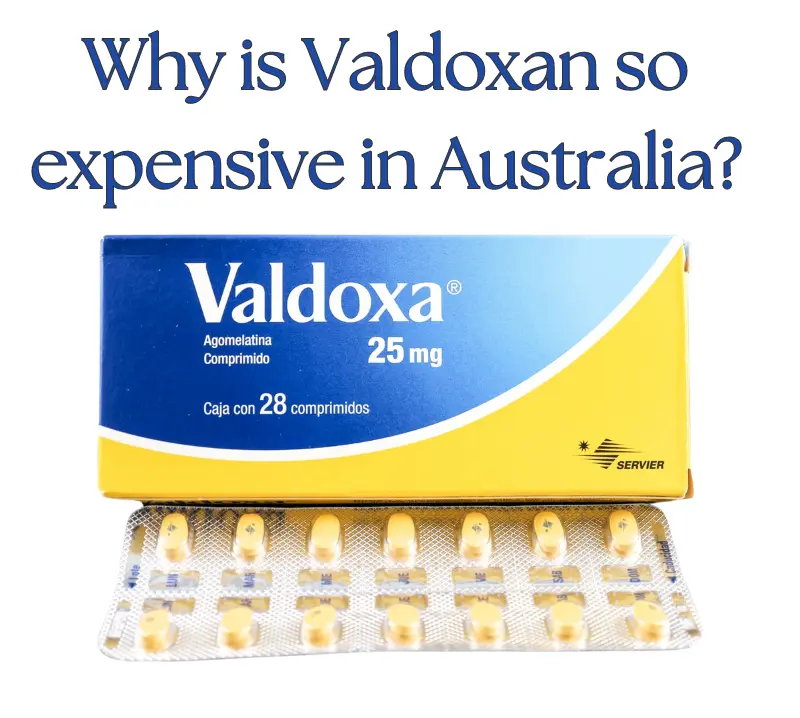Valdoxan, or agomelatine, is a remedy for major depression that stands out among antidepressants and is often referred to as an “Aussie antidepressant.” Although many patients in Australia find it useful, the prohibitive price often makes it hard for them to access the drug. But why is Valdoxan so expensive compared to other antidepressants? There are numerous reasons, including its unique properties and the costs of regulatory controls.
Valdoxan (agomelatine) is relatively expensive in Australia due to several factors. One primary reason is that it is not included in the Pharmaceutical Benefits Scheme (PBS), which means it does not receive government subsidies. This results in patients having to pay the full price, which can be around $50 to $100 per month depending on the pharmacy. In this article, we will explore the main factors driving its high cost and whether it remains affordable for Australian patients.
Innovative mechanism of action and its impact on cost
One of the main reasons Valdoxan is more expensive than other antidepressants, such as SSRIs and SNRIs, is its unique mechanism of action. While most antidepressants aim at serotonin or noradrenaline, Valdoxan targets melatonin receptors and concurrently suppresses serotonin 2C receptors. This dual effect helps restore the body’s circadian rhythm, which is often disrupted in depression.
Valdoxin’s particular interaction with the brain partly explains its higher cost. Pharmaceutical firms spend considerably in developing new pharmaceuticals with specific therapeutic benefits; Valdoxan’s innovative approach distinguishes it from more traditional, older treatments. These development costs are passed on to consumers, as the research, testing, and trials required to bring a new drug to market are costly.
How Valdoxan differs from SSRIs and SNRIs
- Melatonin regulation: Valdoxan controls melatonin receptors, resulting in improved general circadian rhythm and sleep patterns.
- Fewer side effects: Patients using Valdoxan usually have fewer side effects like weight gain and sexual dysfunction, compared to other SSRIs and SNRIs.
Research and development costs
The significant investment in research and development (R&D) is another factor contributing to Valdoxan’s high cost. Every new drug is developed by means of multiple clinical trials to ensure its safety and efficacy. Among other testing, Valdoxan underwent typical antidepressant comparative and placebo-controlled trials.
Valdoxan’s high price reflects the substantial financial outlay required during development. Once approved, companies set prices to recover R&D expenses.
Key R&D costs contributing to Valdoxan’s price:
- Extensive clinical trials: Valdoxan was tested in comparison with SSRIs and SNRIs, among other trials.
- Regulatory approvals: Gaining approval in markets such as Australia and Europe can be time-consuming and expensive.
Patent protection and lack of generics
Valdoxan’s high price is also due to patent protection. Generic replacements shield patented pharmaceuticals from competition, therefore allowing the company to have sole rights to manufacture and distribute of the medication for a defined period of time. Valdoxan is patented by Servier, a pharmaceutical company, making it a rare product.
Generally speaking, generics help to bring Australian prescription costs down. Still, Valdoxan’s prices remain astonishingly expensive without a generic counterpart. Servier controls the pricing till then; but, the market will most certainly see fewer less expensive options once the patent expires.
Key impacts of patent protection:
- Monopoly pricing: Servier alone determines weather Valdoxan is less expensive than generics.
- Lack of competition: In Australia, patients don’t have access to more affordable alternatives due to the patent.
Pharmaceutical Benefits Scheme (PBS) and restricted access
Australia’s Pharmaceutical Benefits Scheme (PBS) helps medications to make them more affordable. Still, the PBS’s partial support for each patient determines Valdoxan’s cost in substantial part. Valdoxan’s PBS accreditation only covers particular clinical diseases, thereby restricting access to the subsidy.
Patients who fail to meet the rigorous PBS requirements are responsible for covering the entire cost, which can be rather expensive. Lack of a subsidy causes many to find Valdoxan quite expensive than other commonly advised antidepressants totally covered by PBS.
PBS restrictions contributing to Valdoxan’s cost:
- Limited eligibility: The PBS payout is only for people who exactly meet specific criteria.
- Out-of-pocket expenses: Many people believe Valdoxan costs more expensive than similar antidepressants.
Liver monitoring requirements
Regular liver function tests mandated of Valdoxan patients raise the overall cost of medication. Valdoxan increased liver enzymes; therefore, even if treatment, doctors have to monitor liver performance. The regular blood tests are set in three, six, twelve, twenty four week intervals.
Apart from doctor appointments, the test expenditures help to determine the total Valdoxan cost. Patients who find the medicine costly already could find the additional medical expenses intolerable.
Liver monitoring requirements:
- Regular tests: Blood tests help one to identify elevated liver enzymes.
- Additional medical expenses: Constant monitoring increases patients’ financial load even in terms of additional medical costs.
Why patients still choose Valdoxan despite its high cost
Valdoxan is a recommended choice for some patients even if it is very costly because of its special benefits and tolerance. Many people point out less adverse effects than with traditional antidepressants. Two usual side effects of SSRIs and SNRIs, Valdoxan has been linked to reduced weight gain and sexual dysfunction. Moreover, since it increases melatonin levels, it encourages sleep, which is a better option for those whose depression grows worse with disturbed sleep.
Benefits of choosing Valdoxan:
- Fewer side effects: Patients report fewer incidences of weight gain and sexual dysfunction.
- Improved sleep: Valdoxan’s effect on melatonin receptors helps patients with sleep disturbances.
- Effective for treatment-resistant depression: When other medications fail to produce results, doctor sometime prescribe Valdoxan for treatment-resistant depression.
Conclusion
While Valdoxan’s price may be prohibitive for some, its innovative properties and potential for better tolerability make it a valuable option for patients in Australia dealing with depression. As with any medication, it’s important to weigh the benefits against the costs to determine if it’s the right choice for your treatment plan.






